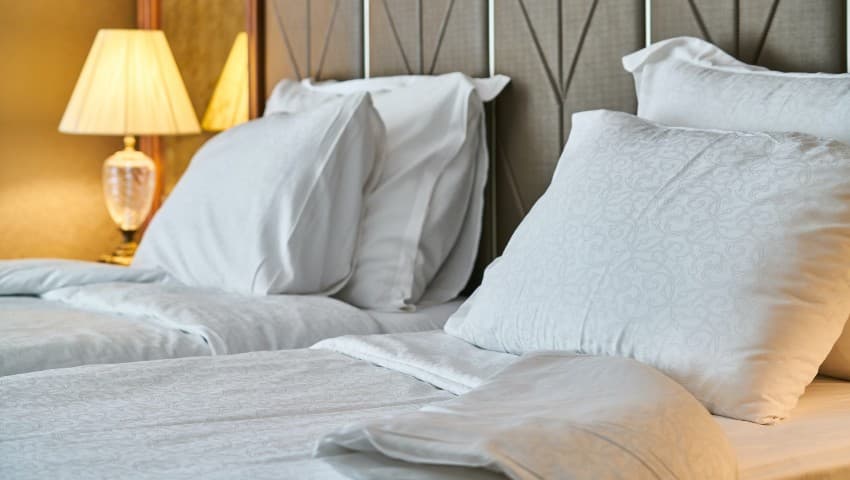Tips for Preventing Bed Bugs

Bed bugs can be stressful to deal with and expensive to get rid of. Read our article for some tips on how to make sure these unwelcome guests never cross your threshold.
Bed bugs are a common and persistent problem in many households. These tiny pests are known for their ability to hide in cracks and crevices, making them difficult to detect and even harder to get rid of. If left unchecked, bed bugs can quickly multiply and infest an entire home, causing itchy bites and a general feeling of discomfort. Fortunately, there are steps you can take to prevent bed bugs and keep your home free from infestation. In this article, we’ll provide you with practical tips for preventing bed bugs and offer advice on how to deal with them if they do make an unwelcome appearance in your home.
Related Read: How To Declutter Your Apartment
Signs of Bed Bugs
Bed bugs are small, flat, reddish-brown insects that feed on the blood of humans and animals. They typically hide in dark, secluded areas like bed frames, mattresses, and furniture. If you notice small, itchy bites on your skin or see blood stains on your sheets, it’s possible that you have bed bugs. Other signs of infestation include the presence of shed skins, eggs, or other waste, which may appear as tiny black dots on your mattress or sheets. By catching an infestation early, you can take steps to prevent it from spreading and causing more serious problems.
Preventing Bed Bugs
There are several practical steps you can take to prevent bed bugs from entering your home:
Tip #1: Vacuum regularly
Regular and thorough vacuuming can help eradicate and reduce bed bug populations, which will ultimately help prevent infestations. Some essential tips to optimize your vacuuming techniques:
Pay special attention to hard-to-reach areas, seams, and edges of the mattress, box springs, bed frames, and nightstands.
Use a stiff brush to dislodge bed bugs and their eggs.
Immediately discard the vacuum cleaner bag when finished.
Tip #2: Use bed bug-proof mattress and pillow covers
Encasing mattresses, box springs, and pillows in bed bug encasements will prevent bed bugs from infesting these areas. They are designed not only to trap bed bugs inside but to allow individuals to spot bed bugs that may be on the outside.
Tip #3: Be cautious when traveling
According to recent surveys, hotel rooms are among the leading areas where bed bug infestations originate. To prevent these pesky bugs from hitchhiking home with you:
Thoroughly inspect hotel rooms for bed bug signs (waste, molted skins, blood stains on sheets, mattress pads, and headboards).
Keep luggage elevated, off the floor, and sealed in plastic bags when not in use.
Tip #4: Avoid using second-hand furniture or bedding
Any item, such as a mattress or a piece of furniture, brought in from the curb or the thrift store should be inspected thoroughly before bringing it inside. Bed bugs can easily hide in upholstered furniture or mattress seams, so it’s better to err on the side of caution and avoid acquiring used items.
Tip #5: Use heat to kill bed bugs
Heat can be an effective bed bug extermination method. By placing items in a dryer that can reach 45 °C or higher for an hour, bed bugs will be killed.
Tip #6: Hire a professional bed bug exterminator
If you suspect a bed bug infestation, take immediate action and hire a specialized pest control technician to handle it promptly. By contacting a licensed professional, you’re making a fast and efficient decision to protect yourself, your family, or your business from the spread of bed bugs. Plus, due to tools like Briostack, pest control technicians can now focus more on customers and less on the administrative side of the business. This means they should be able to fit you in their schedule as soon as you call them.
What To Do If You Think You Have Bed Bugs
If you suspect or have confirmed a bed bug infestation in your home, don’t panic. While it can be a frustrating and stressful situation to deal with, there are several steps you can take to control the infestation effectively and even prevent bed bugs from spreading. Here are some of the most effective steps to follow:
Identify the extent of the infestation
Start by checking all of the rooms in your home for signs of bed bugs, including mattresses, box springs, and bed frames.
Check your bedding, clothing, and furniture for signs of bed bugs. Adult bed bugs look like apple seeds, so you need to look really hard since they’re very small.
Once you identify the extent of the infestation, you can contact a bed bug exterminator to handle the task.
Prepare the area for treatment
Before the bed bug exterminator arrives, it’s essential to prepare the area for treatment:
Strip all the bedding on the mattress, as well as the bed frame, and wash them in hot water.
Remove any clutter in the room and vacuum thoroughly, taking extra care around the bed, baseboards, and nearby furniture.
Seal any cracks, gaps, or holes in the room using a sealant to prevent bed bugs from entering or exiting the area.
Treatment
The exterminator will provide several treatments such as:
Heat treatments that rely on high temperatures to kill off bed bugs and their eggs.
Fumigation that uses chemicals to kill bed bugs.
Pesticides that use insecticides to kill bed bugs.
Follow-up
After the extermination, the exterminator will schedule a follow-up appointment to ensure that the bed bug infestation has been eradicated.
Does Tenant Insurance Cover Bed Bugs?
Unfortunately, tenant insurance policies don’t cover bed bugs, since they’re often considered preventable — insurance providers expect tenants to take preventive measures to avoid
What does tenant insurance cover?
Despite not covering bed bugs, tenant insurance still provides crucial coverage for renters, as it provides peace of mind and financial protection in the event of unexpected damages or losses. Accidents can happen at any time, and without tenant insurance, tenants could face significant financial losses due to theft, fire, or water damage.
Tenant insurance covers personal belongings against theft, damage, or loss caused by unforeseen events and is increasingly required by landlords as protection against tenant-caused damages to the rental unit.
In addition to covering personal property, tenant insurance can also provide liability coverage in case someone gets injured while in the rental unit.
Additional living expenses are also covered by tenant insurance, so if your home becomes uninhabitable due to a covered loss, you won’t have to worry about paying for food and lodging.
APOLLO offers effortless tenant insurance that’s flexible and affordable. Get a free quote in less than a minute and we’ll email your policy documents right to your inbox.
Wondering about what else tenant insurance does and doesn’t cover? Read our article on whether or not your Amazon packages are covered.
Originally published April 20, 2023, updated September 7, 2023
Back to APOLLO MagazineGet a quote in less than a minute
Get no-nonsense coverage that's the best value for your money. Purchase policies from your computer or phone, receive your documents instantly, and save when you buy online.
4.7 rating
Get a quote in less than a minute
Get no-nonsense coverage that's the best value for your money. Purchase policies from your computer or phone, receive your documents instantly, and save when you buy online.
4.7 rating
Relevant articles
Getting insured is as easy as 1 - 2 - 3

Tell us (very little) about yourself
Just tell us your address, your name, email and phone number. And that's it. We'll give you a price in less than a minute.

Pay online easily and securely
You can choose to pay monthly or save money by paying for the entire year in one easy payment.

Get your documents in your inbox - instantly
As soon as you complete your purchase, you'll find your proof of insurance and policy documents waiting for you in your inbox.
Get covered today - it couldn’t be easier
We’ve provided more than 1,000,000 quotes to Canadians just like you. Give it a try!



